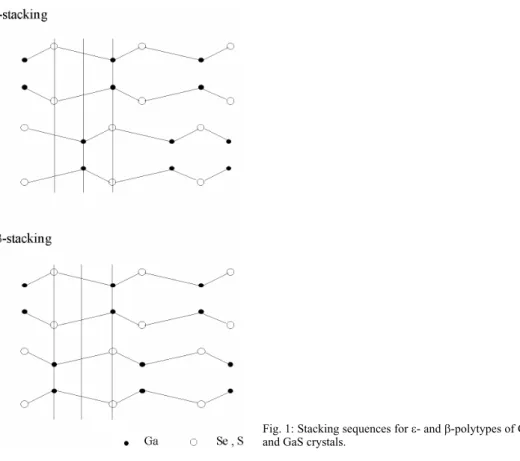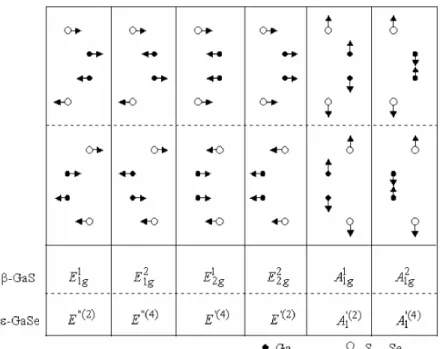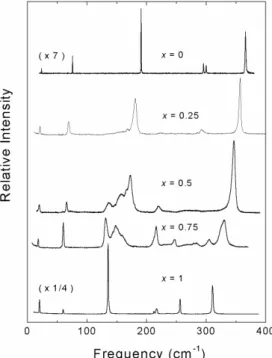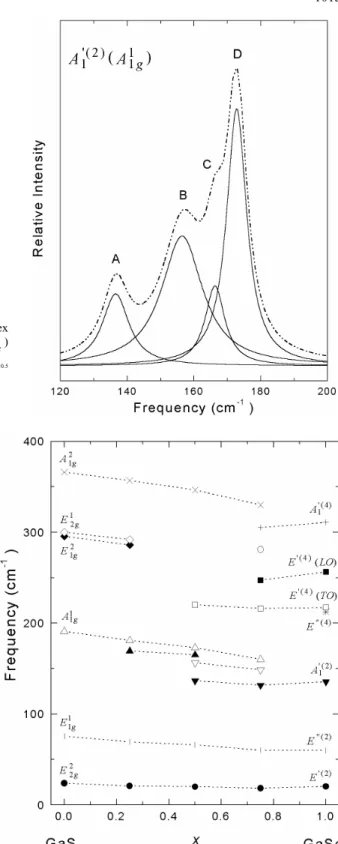© 2002 WILEY-VCH Verlag GmbH & Co. KGaA, Weinheim 0232-1300/02/0909-1011 $ 17.50+.50/0
N. M. GASANLY*1
, A. AYDINLI2
1Department of Physics, Middle East Technical University, 06531 Ankara, Turkey
2Department of Physics, Bilkent University, 06533 Ankara, Turkey
Low-Temperature Raman Scattering Spectra of GaSe
xS
1-xLayered Mixed Crystals
Raman scattering has been used to study the vibrational spectra of GaSexS1-xlayered mixed crystals at 10 K. We report the frequency dependencies of different modes on composition x , with particular emphasis on A1'(2)(A1g1 ) and A1'(4)(A1g2 ) intralayer compressional modes having low dispersion in the Brillouin zone. The appearance of additional bands is attributed to multimode behavior typically exhibited by mixed crystals of anisotropic compounds.
Keywords: Raman scattering, layered mixed crystals, GaSexS1-x (Received April 30, 2002; Accepted May 29, 2002)
1. Introduction
GaS and GaSe are layered compounds, in which bonds within the layers are considerably stronger than those perpendicular to the layers. Their structures may be considered as two-dimensional, as a consequence of strong ionic-covalent intralayer and weak van der Waals interlayer interactions. The distinctive interatomic forces in layered structures manifest themselves with typical features in their phonon spectra, for example weak dispersion of phonon branches in some directions in the Brillouin zone and low-frequency interlayer modes.
The layer compounds GaS and GaSe form a series of GaSexS1-xmixed crystals with no
restrictions on the concentrations of the components: 0≤ x ≤ 1 (MASUIet al.; OSMAN). The
phonon spectra of GaSexS1-x mixed crystals at room temperature have been deduced
previously from Raman and Brillouin scattering (HAYEK et al.; MERCIER, VOITCHOVSKY;
GASANLY et al.; YAMADA et al.) and infrared reflection (RIEDE et al.; GASANLY et al.)
measurements.
We present in this paper for the first time the experimental results on Raman scattering
from GaSexS1-xmixed crystals at T = 10 K. We report the frequency shifts of different modes,
in particular the A1'(2)(A ) and1g1 A1'(4)(A ) intralayer compressional modes, with composition1g2
of the mixed crystals. The appearance of additional bands in the region 135-190 cm-1
is attributed to multimode behavior typical for mixed crystals of anisotropic compouds. We discuss anomalies observed in the spectra for the intralayer A1'(2)(A ) compressional modes1g1 due to polytype transformations.
x 1-x
2. Crystal symmetry and group-theoretical analysis
The GaSexS1-x mixed crystals, like the pure compounds GaS and GaSe, have a layered
structure. Each of the layers comprises four atomic planes with the sequence S(Se) - Ga - Ga
- S(Se). Depending on the layer stacking, polytypesε , β, and γ are distinguished (KUHNet
al. 1975, 1976). Figure 1 shows schematically the stacking arrangement of two neighboring
layers in theε- and β-polytypes. GaSe crystals grown from the melt by the Bridgman method
present only the parallelε-polytype whereas GaS crystals invariably present the antiparallel
β modification, which is also sometimes found in vapor-grown GaSe. The GaSexS1-xmixed
crystals change their polytype (β → ε) with increase of x from 0 to 1: for 0 ≤ x ≤ 0.4 and 0.6
≤ x ≤ 1 the β- and ε-polytypes predominate, respectively; for intermediate region the mixture
of two polytypes occurs (KYAZYMZADEet al.).
Fig. 1: Stacking sequences forε- and β-polytypes of GaSe
and GaS crystals.
The space group of β-GaS and ε-GaSe crystals are D6h4 and D3h1 , respectively (HAYEK et
al.). In theβ- and ε-type structures, the primitive hexagonal unit cell consists of four formula units from two neighboring layers. For GaS, there are 24 normal modes of vibration at the center of the Brillouin zone and these can be described by the irreducible representations of the D6hpoint group
Thus, there are six Raman-active modes (2A1g+ 2E1g+ 2E2g ) and two infrared-active modes
(E1u+ A2u).
Forε-polytype of GaSe, 24 normal modes are given by the irreducible representations of
the D3hpoint group
Γ ≡ 4 '
1
A + 4A2'' + 4E’
+ 4E’’
.
In this case, there are eleven Raman-active modes (4A1'+ 3E’
+4E’’
) and six infrared-active modes (3A2''+ 3E’
). One of the Raman-active 3E’
modes (E’(2)
) and acoustic mode E’(1)
are counterparts of one of the six Davydov doublets. The remaining ten Raman-active modes (4A1'+ 2E’+4E”) are components of five Davydov doublets (YOSHIDAet al.).
The symmetry coordinates found by Melvin projection operator method (MELVIN) were
used to obtain the displacement vectors of atoms in all phonon modes of GaS and GaSe crystals. Figure 2 shows the atomic displacement vectors for Raman-active interlayer and intralayer modes. As seen from this figure, in these modes all the gallium and sulfur (selenium) atoms move either perpendicular or parallel to the layers.
Fig. 2: Atomic displacement vectors for interlayer and intralayer Raman-active optical modes of
β-GaS andε-GaSe layered crystals.
3. Experimental details
Single crystals of GaSexS1-x were grown by Bridgman method. The analysis of X-ray
diffraction data showed that they crystallize in a hexagonal unit cell. Crystals suitable for measurements were obtained by easy cleaving perpendicular to optical c-axis. Raman scattering measurements were performed in the back-scattering geometry in the frequency
x 1-x
range 10-400 cm-1
. The 514.5 nm line of an argon laser and He-Ne laser (632.8 nm) were used as the exciting light sources. The scattered light was analyzed using a “Jobin Yvon” U-1000 double grating spectrometer and a cooled GaAs photomultiplier supplied with the standard photon counting electronics. The Raman line positions were determined within an
accuracy of ± 0.1 cm-1
. A “CTI-Cryogenics M-22” closed cycle helium cryostat was used to cool the crystals from room temperature down to 10 K. The temperature was controlled within an accuracy of ± 0.5 K. In order to avoid sample-heating effects, we have chosen a cylindrical lens to focus the incident beam on the sample.
4. Results and discussion
Figure 3 represents the Raman spectra of GaSexS1-x mixed crystals at 10 K. These
low-temperature measurements have demonstrated directly that all observed bands are due to
one-phonon processes. Figure 4 shows the decomposition of the Raman spectra of GaSe0.5S0.5
crystal at the frequencies corresponding to the A1'(2)(A ) intralayer compressional modes1g1 which have four distinct lines, two of which (A and D) are genetically related to the stretching vibration of atoms in the binary crystals GaSe and GaS, respectively, while the B and C lines have frequencies intermediate to A and D lines. Thus, in GaSe0.5S0.5mixed crystal
this stretching vibration of atoms shows a four-mode behavior. The dependencies of the
frequencies of Raman-active modes on the compositions of GaSexS1-x mixed crystals are
depicted in Fig. 5. One-mode behavior of interlayer E’(2)
(E ) and intralayer E2g2 ”(2)
(E ) shear1g1 modes, and two-mode behavior of intralayer E”(4)(E ) and E1g2 ‘(4)(E ) shear modes, polarized12g
along the layer, is in agreement with that of Ref. (HAYEKet al.; MERCIER, VOITCHOVSKY).
Fig. 3: Raman spectra of GaSexS1-xmixed crystals at
Fig. 4: The decomposition of the complex
contour of the Raman-active '(2)
1
A ( 1
1g
A ) compressional mode (dotted line) of GaSe0.5S0.5
mixed crystal into components.
Fig. 5: Frequency dependencies of
Raman-active modes on composition of GaSexS1-xmixed crystals.
x 1-x
Let us consider in detail the behavior of the intralayer compressional modes. The anisotropy of the crystal structure of GaSexS1-xleads to a perceptible difference in the dispersion in the Brillouin zone for intralayer shear and compressional modes polarized along and perpendicular to the layer, respectively. The rearrangement and the composition dependence of the intralayer mode frequencies in mixed crystals may be described by the cell
isodisplacement model in some cases (ZINGERet al.; BARTAet al.). This model holds for
modes with low dispersion in the Brillouin zone. Therefore, such a model may be applicable to the A1'(2)(A ) and1g1 A1'(4)(A ) intralayer compressional modes of the GaSe1g2 xS1-x mixed
crystal, polarized perpendicular to the layers (Fig. 2). These modes in GaSe and GaS layer crystals have very low dispersion in the Brillouin zone due to a weak interlayer interaction
(JANDLet al.; POWELLet al.). Distinctly observed four-mode behavior in the Raman spectra
of the GaSe0.5S0.5mixed crystal for the
'(2) 1
A (A ) intralayer compressional mode (Figs. 3-5)1g1
may be explained by the cell isodisplacement model. Three different kinds of cell singled out in the layer of mixed crystal, namely, Se – Ga Ga Se, Se Ga Ga S, and S Ga Ga -S, may be identified with a certain set of normal vibrations, corresponding to each cell. Mixed cells composed of Se - Ga - Ga - S can be formed during the growth of the crystals.
As stated above, the lines A and D are genetically related to the stretching vibration of atoms in binary crystals GaSe and GaS, respectively. The lines B and C associated with the mixed cells Se - Ga - Ga - S are expected to have different frequencies in different stacking configurations. The motion of the atoms in the mixed cells Se - Ga - Ga - S is perpendicular to the layers. A change of the interlayer interaction, due to a change in the stacking, affects
the mode frequencies associated with the mixed cells. In GaSe0.5S0.5 mixed crystal, two
stackings (ε- and β-polytypes) coexist and the B and C lines can be observed simultaneously.
The arrangement of the adjacent layers in β-polytype is different from that in ε-polytype.
This leads to an alignment of cations and anions such that an ionic contribution to the weak
interlayer bonding results for theβ-polytype (Fig. 1). The calculations with the linear chain
model shows that interlayer compressional constant is about three times larger inβ-stacking
than inε-stacking (MERCIER, VOITCHOVSKY). Therefore, we may assign B and C lines (νB<
νC) in the Raman spectra of GaSe0.5S0.5mixed crystal to vibration of atoms in theε- and
β-stackings, respectively.
The rearrangement behavior of high-frequency A1'(4)(A ) compressional mode differs1g2
from the one-mode behavior reported earlier (HAYEKet al.; MERCIER, VOITCHOVSKY). In the
Raman spectra of GaSexS1-xmixed crystals an unusual two-mode behavior is observed for this
vibration (Figs. 3,5). The intensity of the line originating from stretching vibrations of atoms in the binary GaSe crystal decreases faster than that in binary GaS crystal. Therefore, in the
Raman spectra from GaSexS1-xmixed crystals with x < 0.75 we observe in the 305-365 cm
-1
range one line corresponding to the pure component GaS. Besides those two bands, a third additional band of low intensity is observed for x = 0.75, having a lower frequency than the above two bands. Similar unusual two-mode behavior has been predicted earlier for
stretching mode ν4 in Hg2(ClxBr1-x)2 chain mixed crystals (BARTA et al.). There, it was
proposed that this additional band is due to complex relative motions of the atoms in disordered sublattices. With these vibrations, the change in the polarizibility is slight and they can appear in the Raman spectra as weak bands.
Different behavior of A1'(2)(A ) and1g1 A1'(4)(A ) compressional modes may be associated1g2 with the difference in sets of atomic displacements for these modes. For the A1'(2)(A ) mode1g1 the restoring forces are due to strong intralayer gallium-gallium ( CGa-Ga= 108 and CGa-Ga= 110
N/m for GaSe (WIETING) and GaS (LUCAZEAU), respectively) and weak interlayer
selenium-selenium (sulfur-sulfur) (CSe-Se= 9.2 and CS-S= 9.5 N/m) bonds. In
'(4) 1
A (A ) mode, stronger1g2
intralayer gallium-selenium (sulfur) (CGa-Se = 123 and CGa-S = 130 N/m) bonds are also
involved in restoring forces (Fig. 2). Here C is the compressional force constant associated with the relative displacements of the atomic planes. Thus, the frequency of the A1'(4)(A )1g2 mode is essentially determined by the relative motions of the atoms within one layer. Note that the intramolecular stretching modeν4in Hg2(ClxBr1-x)2mixed crystals also arises from the
relative vibrations of both mercury-mercury and mercury-chlorine (bromine) atoms (BARTA
et al.).
Acknowledgement
We would like to thank C. Kocabas and R. Pala for their assistance.
References
BARTA, C., DOBRZHANSKI, G. F., ZINGER, G. M., LIMONOV, M. F., MARKOV, Yu. F.: Sov. Phys.-Solid State 24 (1982) 1672.
GASANLY, N. M., GONCHAROV, A. F., MELNIK, N. N., RAGIMOV, A. S.: Phys. Stat. Sol. (b) 120 (1983) 137.
HAYEK, M., BRAFMAN, O., LIETH, R. M. A.: Phys. Rev. B 8 (1973) 2772. JANDL, S., BREBNER, J.L., POWELL, B.M.: (1976) Phys. Rev. B 13 (1973) 686.
KUHN, A., CHEVY, A., CHEVALIER, R.: Phys. Stat. Sol. (a) 31 (1975) 469; Phys. Stat. Sol. (a) 36 (1976) 181.
KYAZYMZADE, A. G., MEKHTIEV, N. M., SAMEDOV, Z. S., TAGIROV, V. I.: Sov. Phys.- Solid State 26 (1984) 737.
LUCAZEAU, G.: Solid State Commun. 18 (1976) 917.
MASUI, A., ONARI, S., ALLAKHVERDIEV, K. R., GASHIMZADE, F., MAMEDOV, T.: Phys. Stat. Sol. (b) 223 (2001) 139.
MELVIN, M. A.: Rev. Mod. Phys. 28 (1956) 18.
MERCIER, A., VOITCHOVSKY, J. P.: Solid State Commun. 14 (1974) 757. OSMAN, M. A.: Physica B 275 (2000) 351.
POWELL, B.M., JANDL, S., BREBNER, J.L., LEVY, F.: J. Phys. C : Solid State Phys. 10 (1977) 3039. RIEDE, V., NEUMANN, H., SOBOTTA, H., LEVY, F.: Solid State Commun. 34 (1980) 229.
WIETING, T. J.: Solid State Commun. 12 (1973) 931.
YAMADA, M., SHIMUZU, H., MAEGAWA, S., YAMAMOTO, K., ABE, K.: Physica B 105 (1981) 334. YOSHIDA, H., NAKASHIMA, S., MITSUISHI, A.: Phys. Stat. Sol. (b) 59 (1973) 655.



